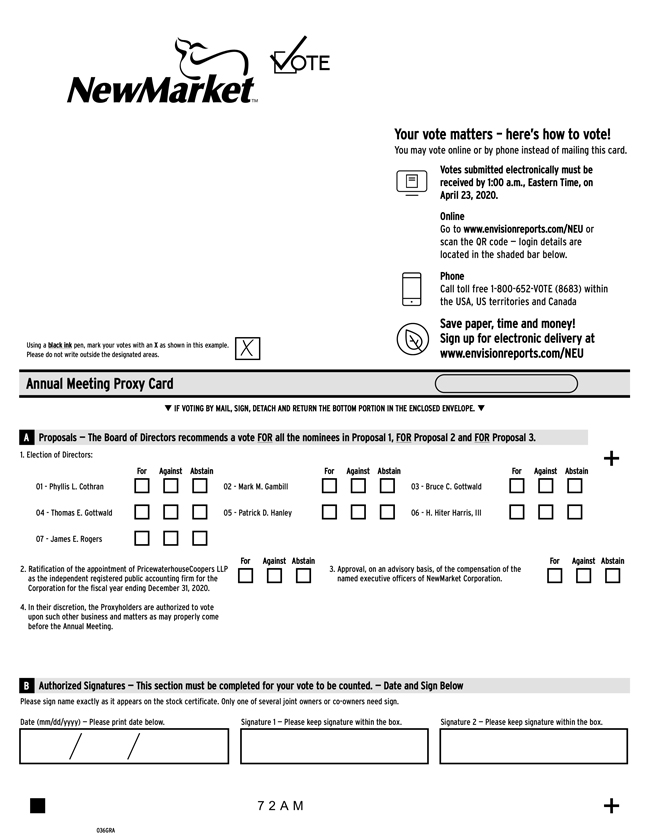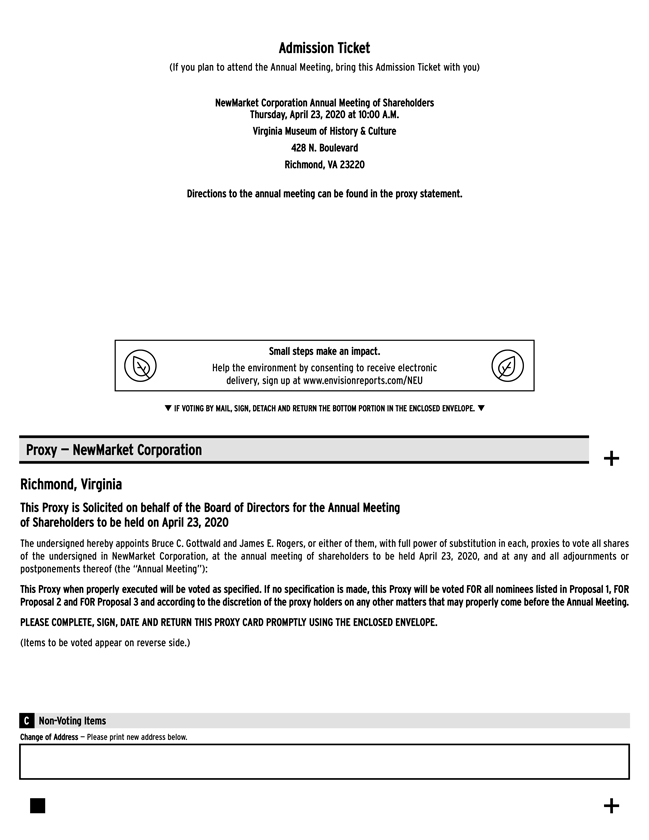Independence Determination Guidelines
For a director to be deemed “independent,” the Board of Directors of NewMarket Corporation (“NewMarket”) shall affirmatively determine that the director has no material relationship with NewMarket either directly or as a partner, shareholder or officer of an organization that has a relationship with NewMarket. In making this determination, the Board of Directors shall apply the following standards, in which case a director will be deemed not independent:
| 1. | A director is, or has been within the last three years, an employee of NewMarket, or an immediate family member is, or has been within the last three years, an executive officer, of NewMarket. Employment as an interim Chairman, Chief Executive Officer or other executive officer will not disqualify a director from being considered independent following such employment. |
| 2. | A director has received or has an immediate family member, serving as an executive officer, who has received, during any twelve-month period within the last three years, more than $120,000 in direct compensation from NewMarket (excluding director and committee fees and pensions or other forms of deferred compensation for prior service, provided such compensation is not contingent in any way on continued service). Compensation received by a director for former service as an interim Chairman, Chief Executive Officer or other executive officer will not count toward the $120,000 limitation. |
| 3. | (A) A director or an immediate family member is a current partner of a firm that is NewMarket’s internal or external auditor; (B) a director is a current employee of such a firm; (C) a director has an immediate family member who is a current employee of such a firm and who personally participates in the audit of NewMarket; or (D) a director or an immediate family member was within the last three years (but is no longer) a partner or employee of such a firm and personally worked on NewMarket’s audit within that time. |
| 4. | A director or an immediate family member is, or has been within the last three years, employed as an executive officer of another company where any of NewMarket’s present executive officers at the same time serves or served on that company’s compensation committee. |
| 5. | A director is a current employee, or an immediate family member is a current executive officer, of a company that has made payments to, or received payments from, NewMarket for property or services in an amount which, in any of the last three fiscal years, exceeds the greater of $1 million, or 2% of such other company’s consolidated gross revenues. |

|
|
Admission Ticket
Electronic Voting Instructions
Available 24 hours a day, 7 days a week!
InsteadYour vote matters – here’s how to vote! You may vote online or by phone instead of mailing your proxy, you may choose one of the voting methods outlined below to vote your proxy.
VALIDATION DETAILS ARE LOCATED BELOW IN THE TITLE BAR.
Proxiesthis card. Votes submitted by the Internet or telephoneelectronically must be received by 1:00 a.m., Eastern Time, on April 27, 2017.
|
Vote by telephone
•23, 2020. Online Go to www.envisionreports.com/NEU or scan the QR code — login details are located in the shaded bar below. Phone Call toll free1-800-652-VOTE (8683) within the USA, US territories &and Canada onSave paper, time and money! Sign up for electronic delivery at www.envisionreports.com/NEU Using a touch tone telephone
• Followblack ink pen, mark your votes with an X as shown in this example. Please do not write outside the instructions provided by the recorded message

qdesignated areas. Annual Meeting Proxy Card IF YOU HAVE NOT VOTED VIA THE INTERNETOR TELEPHONE, FOLD ALONG THE PERFORATION,VOTING BY MAIL, SIGN, DETACH AND RETURN THE BOTTOM PORTION IN THE ENCLOSED ENVELOPE.q
A Proposals — The Board of Directors recommends a voteFOR all the nominees in Proposal 1,FOR Proposal 2 and FOR Proposal 33. 1. Election of Directors: 01—Phyllis L. Cothran 04—Thomas E. Gottwald 07—James E. Rogers For Against Abstain 02—Mark M. Gambill 05—Patrick D. Hanley For Against Abstain 03—Bruce C. Gottwald 06—H. Hiter Harris, III For Against Abstain 2. Ratification of the appointment of PricewaterhouseCoopers LLP as the independent registered public accounting firm for the Corporation for the fiscal year ending December 31, 2020. 4. In their discretion, the Proxyholders are authorized to vote upon such other business and forONEYEAR for Proposal 4.
| matters as may properly come before the Annual Meeting. For Against Abstain 3. Approval, on an advisory basis, of the compensation of the named executive officers of NewMarket Corporation. For Against Abstain |
| |||||||||||||||||||||||||
|
|
|
|
|
|
|
|
|
|
|
| |||||||||||||||
| For | Against | Abstain | For | Against | Abstain | |||||||||||||||||||||||||
| 2. | Ratification of the appointment of PricewaterhouseCoopers LLP as the independent registered public accounting firm for the Corporation for the fiscal year ending December 31, 2017. | ☐ | ☐ | ☐ | 3. | Approval, on an advisory basis, of the compensation of the named executive officers of NewMarket Corporation. | ☐ | ☐ | ☐ | |||||||||||||||||||||
| 1 Year | 2 Years | 3 Years | Abstain | |||||||||||||||||||||||||||
| 4. | Approval, on an advisory basis, of the frequency of holding an advisory vote on executive compensation. | ☐ | ☐ | ☐ | ☐ | 5. | In their discretion, the Proxyholders are authorized to vote upon such other business and matters as may properly come before the Annual Meeting. | |||||||||||||||||||||||
BNon-Voting Items
Change of Address— Please print new address below.
C Authorized Signatures — This section must be completed for your vote to be counted. — Date and Sign Below
Please sign name exactly as it appears on the stock certificate. Only one of several joint owners orco-owners need sign. Date (mm/dd/yyyy) — Please print date below. Signature 1 — Please keep signature within the box. Signature 2 — Please keep signature within the box. 72AM 036GRA
|
|
| ||||||
02J1BA

